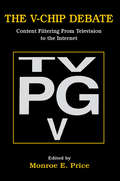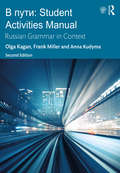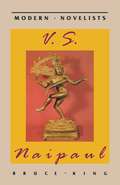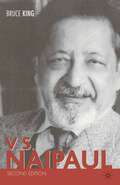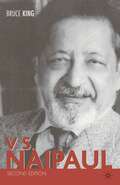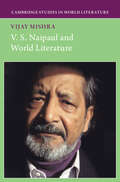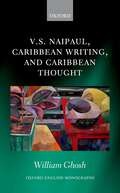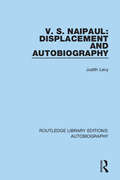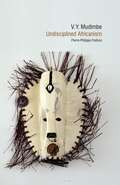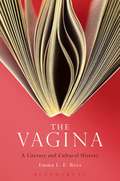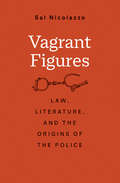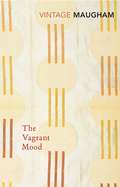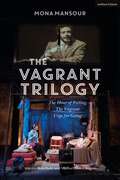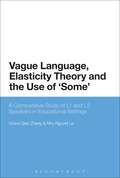- Table View
- List View
UX on the Go: A Flexible Guide to User Experience Design
by Andrew MaraDesigned with flexibility and readers’ needs in mind, this purpose driven book offers new UX practitioners succinct and complete intructions on how to conduct user research and rapidly design interfaces and products in the classroom or the office. With 16 challenges to learn from, this comprehensive guide outlines the process of a User Experience project cycle from assembling a team to researching user needs to creating and veryifying a prototype. Practice developing a prototype in as little as a week or build your skills in two-, four-, eight-, or sixteen-week stretches. Gain insight into individual motivations, connections, and interactions; learn the three guiding principles of the design system; and discover how to shape a user’s experience to achieve goals and improve overall immediate experience, satisfaction, and well-being. Written for professionals looking to learn or expand their skills in user experience design and students studying technical communication, information technology, web and product design, business, or engingeering alike, this accessible book provides a foundational knowledge of this diverse and evolving field. A companion website will include examples of contemporary UX projects, material to illustrate key techniques, and other resources for students and instructors. Access the material at uxonthego.com.
UX Writing: Designing User-Centered Content
by Jason C.K. Tham Tharon Howard Gustav VerhulsdonckThis flexible textbook provides an integrated approach to user experience (UX) writing and equips students and practitioners with the essential principles and methods to succeed in writing for UX. The fundamental goal of UX writing is to produce usable and attractive content that boosts user engagement and business growth. This book teaches writers how to create content that helps users perform desired tasks while serving business needs. It is informed by user-centered design, content strategy, artificial intelligence (AI), and digital marketing communication methodologies, along with UX-related practices. By combining writing-as-design and design-as-writing, the book offers a new perspective for technical communication education where UX design and writing are merged to achieve effective and desirable outcomes. Outlining the key principles and theories for writing user-centered content design, this core textbook is fundamental reading for students and early career practitioners in UX, technical communication, digital marketing, and other areas of professional writing.
UX Writing: Designing User-Centered Content
by Jason C.K. Tham Tharon Howard Gustav VerhulsdonckThis flexible textbook provides an integrated approach to user experience (UX) writing and equips students and practitioners with the essential principles and methods to succeed in writing for UX. The fundamental goal of UX writing is to produce usable and attractive content that boosts user engagement and business growth. This book teaches writers how to create content that helps users perform desired tasks while serving business needs. It is informed by user-centered design, content strategy, artificial intelligence (AI), and digital marketing communication methodologies, along with UX-related practices. By combining writing-as-design and design-as-writing, the book offers a new perspective for technical communication education where UX design and writing are merged to achieve effective and desirable outcomes. Outlining the key principles and theories for writing user-centered content design, this core textbook is fundamental reading for students and early career practitioners in UX, technical communication, digital marketing, and other areas of professional writing.
The V-chip Debate: Content Filtering From Television To the Internet (Routledge Communication Series)
by Monroe E. PriceThe V-chip is a highly significant part of the discussion about whether television (or broadcasting in general) deserves some special attention in terms of its accessibility to children, its particular power to affect conduct, and its invasiveness. But as this notion of filtering and labeling has caught the imagination of the regulator, the legislator, and all those who wish to consider new ways to alter bargaining over imagery in society, the very idea of the V-chip or its equivalent is moving across other technologies, including the Internet. The V-chip issue has also fueled the ongoing debate about violence and sexual practices in society, and how representations on television relate to those practices. Although the initial concept of the V-chip is simple, its flow into the public realm raises so many extraordinary questions that the introduction and production of the chip virtually serves as a case study in problems of law and public policy. The very conceptualization of speech in society is being affected by this issue. Accordingly, the place of the V-chip in this debate is increasingly important; indeed, it may be argued that the V-chip's contribution to legal argumentation may be greater than its ultimate contribution to the relationship between children and imagery. Among the questions the contributors address are: *What research basis is necessary to require a framework for labeling and rating? *What relationship between government and the image-producing industries can be characterized--for constitutional and other reasons--as voluntary as opposed to coercive? *Who should evaluate these images? *To what extent should the evaluation process be centralized and/or distributed? *What assessment is appropriate to evaluate whether the experiment is "successful?" In addition to the V-chip's origin's in Canada and its further evolution in the United States, this book discusses the development of the V-chip and television rating systems in Europe, Australia, and throughout the world. It also includes essays which contrast the very different approaches in Canada and the United States in terms of the role of regulatory agency, industry, and government.
The V-chip Debate: Content Filtering From Television To the Internet (Routledge Communication Series)
by Monroe E. PriceThe V-chip is a highly significant part of the discussion about whether television (or broadcasting in general) deserves some special attention in terms of its accessibility to children, its particular power to affect conduct, and its invasiveness. But as this notion of filtering and labeling has caught the imagination of the regulator, the legislator, and all those who wish to consider new ways to alter bargaining over imagery in society, the very idea of the V-chip or its equivalent is moving across other technologies, including the Internet. The V-chip issue has also fueled the ongoing debate about violence and sexual practices in society, and how representations on television relate to those practices. Although the initial concept of the V-chip is simple, its flow into the public realm raises so many extraordinary questions that the introduction and production of the chip virtually serves as a case study in problems of law and public policy. The very conceptualization of speech in society is being affected by this issue. Accordingly, the place of the V-chip in this debate is increasingly important; indeed, it may be argued that the V-chip's contribution to legal argumentation may be greater than its ultimate contribution to the relationship between children and imagery. Among the questions the contributors address are: *What research basis is necessary to require a framework for labeling and rating? *What relationship between government and the image-producing industries can be characterized--for constitutional and other reasons--as voluntary as opposed to coercive? *Who should evaluate these images? *To what extent should the evaluation process be centralized and/or distributed? *What assessment is appropriate to evaluate whether the experiment is "successful?" In addition to the V-chip's origin's in Canada and its further evolution in the United States, this book discusses the development of the V-chip and television rating systems in Europe, Australia, and throughout the world. It also includes essays which contrast the very different approaches in Canada and the United States in terms of the role of regulatory agency, industry, and government.
V Puti: Russian Grammar in Context
by Frank Miller Olga Kagan Anna KudymaThis highly successful program assists in the development of all the language skills (listening, speaking, reading and writing) by presenting realistic settings, situations and contexts. It consists of 12 chapters and can be used in an intermediate or advanced Russian course. V Puti offers conversational exercises, various readings (biographies, poems, literature and historical texts) and grammatical explanations and practice. All of these components reinforce Russian culture and history which enable the students to understand the Russian language in context. V Puti: Student Activities Manual is an integral part of the V Puti course. The structure matches the main textbook and provides a wealth of exercises and activities, either for class-use or homework.
V Puti: Russian Grammar in Context
by Frank Miller Olga Kagan Anna KudymaThis highly successful program assists in the development of all the language skills (listening, speaking, reading and writing) by presenting realistic settings, situations and contexts. It consists of 12 chapters and can be used in an intermediate or advanced Russian course. V Puti offers conversational exercises, various readings (biographies, poems, literature and historical texts) and grammatical explanations and practice. All of these components reinforce Russian culture and history which enable the students to understand the Russian language in context. V Puti: Student Activities Manual is an integral part of the V Puti course. The structure matches the main textbook and provides a wealth of exercises and activities, either for class-use or homework.
V. S. Naipaul (Modern Novelists)
by Bruce KingThis is a user-friendly introduction to the novels and the non-fiction of V.S. Naipaul that will be of interest both to the student and to the specialist. It examines the language, structure, themes and development of Naipaul's writing, setting the novels in their autobiographical, philosophical, social and political, colonial and post-colonial contexts. Attention is given to Naipaul's existentialism, relationship to his literary models, use of Indian philosophy and vision of the Indian diaspora. Naipaul is shown to use similar formal literary structures and to have recurring themes and preoccupations during the four distinctive periods of his writing.
V.S. Naipaul
by Bruce KingV. S. Naipaul is a reader-friendly introduction to the writing of one of the most influential contemporary authors and the 2001 Nobel laureate in Literature. Bruce King provides a novel by novel analysis of the fiction with attention to structure, significance, and Naipaul's development as a writer, while setting the texts in their autobiographical. philosophical, social, political, colonial and postcolonial contexts. King shows how Naipaul modified Western and Indian literary traditions for the West Indies and then the wider world to become an international writer whose subject matter includes the Caribbean, England, India, Africa, the United States, Argentina, and contemporary Islam.Thoroughly revised and updated, the second edition of V. S. Naipaul now includes an expanded Introduction, and discussion of his most recent novels A Way in the World and Half a Life, his Nobel Lecture, Naipaul's writings on Islam, and a survey of the main criticism by other writers and postcolonial theorists.
V.S. Naipaul
by Bruce KingV. S. Naipaul is a reader-friendly introduction to the writing of one of the most influential contemporary authors and the 2001 Nobel laureate in Literature. Bruce King provides a novel by novel analysis of the fiction with attention to structure, significance, and Naipaul's development as a writer, while setting the texts in their autobiographical. philosophical, social, political, colonial and postcolonial contexts. King shows how Naipaul modified Western and Indian literary traditions for the West Indies and then the wider world to become an international writer whose subject matter includes the Caribbean, England, India, Africa, the United States, Argentina, and contemporary Islam.Thoroughly revised and updated, the second edition of V. S. Naipaul now includes an expanded Introduction, and discussion of his most recent novels A Way in the World and Half a Life, his Nobel Lecture, Naipaul's writings on Islam, and a survey of the main criticism by other writers and postcolonial theorists.
V. S. Naipaul and World Literature (Cambridge Studies in World Literature)
by null Vijay MishraV. S. Naipaul is a major and controversial figure in postcolonial and world literature. This book provides a challenging and uncompromisingly honest study that engages with history, genre theory, aesthetics, and global literary culture, with close reference to Naipaul's published and archival material. In his fiction and creative histories, the definition of the modern idea of world literature is informed by the importance of an artistic ordering of perception. Although often expressing ideas that are prejudicial and morally repugnant, there is an honesty in his writings where one finds extraordinary insights into how life is experienced within colonial structures of power. These colonial structures provided no abstract unity to the field of literary expression and ignored vernacular cultures. The book argues that a universal ideology of the aesthetic, transcending time, regions, and languages, provides world literature with a unity which is possible only within a critical universal humanism attuned to heroic readings of texts and cultures.
V.S. Naipaul, Caribbean Writing, and Caribbean Thought (Oxford English Monographs)
by William GhoshV.S. Naipaul was one of the most influential and controversial writers of the twentieth century. His writings on colonialism and its aftermath, on migration and landscape, and on cultural loss and creativity, were both admired and criticised by a wide global audience. But what of his relationship to the region of his birth? Born in Trinidad, of Indian ancestry, and spending his professional life in England, Naipaul could be dismissive of his Caribbean background. He presented himself as a citizen of nowhere, or else, of the globalized, postcolonial world. However, this obscures his intense competition, fierce disagreements and close collaboration with other Caribbean intellectuals, both as a schoolchild in colonial Trinidad, and as an internationally celebrated author. V.S. Naipaul, Caribbean Writing, and Caribbean Thought looks again at Naipaul's relationship with his birthplace. It shows that that the decolonising Caribbean was the crucible in which Naipaul's style and outlook were formed. Moreover, understanding Naipaul's place in the history of the region's politics and letters sheds new light on the work of celebrated contemporaries, Derek Walcott and Kamau Brathwaite, George Lamming and Maryse Condè, Elsa Goveia and Eric Williams, Sylvia Wynter and C.L.R. James. Literary criticism, intellectual biography, and an essay in the history of ideas, this book offers a new account of Caribbean thought in the decades after independence. It reveals a literary culture of creative vibrancy, in an era of unprecedented change.
V.S. Naipaul, Caribbean Writing, and Caribbean Thought (Oxford English Monographs)
by William GhoshV.S. Naipaul was one of the most influential and controversial writers of the twentieth century. His writings on colonialism and its aftermath, on migration and landscape, and on cultural loss and creativity, were both admired and criticised by a wide global audience. But what of his relationship to the region of his birth? Born in Trinidad, of Indian ancestry, and spending his professional life in England, Naipaul could be dismissive of his Caribbean background. He presented himself as a citizen of nowhere, or else, of the globalized, postcolonial world. However, this obscures his intense competition, fierce disagreements and close collaboration with other Caribbean intellectuals, both as a schoolchild in colonial Trinidad, and as an internationally celebrated author. V.S. Naipaul, Caribbean Writing, and Caribbean Thought looks again at Naipaul's relationship with his birthplace. It shows that that the decolonising Caribbean was the crucible in which Naipaul's style and outlook were formed. Moreover, understanding Naipaul's place in the history of the region's politics and letters sheds new light on the work of celebrated contemporaries, Derek Walcott and Kamau Brathwaite, George Lamming and Maryse Condè, Elsa Goveia and Eric Williams, Sylvia Wynter and C.L.R. James. Literary criticism, intellectual biography, and an essay in the history of ideas, this book offers a new account of Caribbean thought in the decades after independence. It reveals a literary culture of creative vibrancy, in an era of unprecedented change.
V. S. Naipaul: Displacement and Autobiography (Routledge Library Editions: Autobiography)
by Judith LevyOriginally published in 1995. V. S. Naipaul, a Trinidadian of Indian descent living in the West, has written in many forms. Through an analysis of five works by Naipaul written in different modes and periods of his life, this study posits a relationship between a cultural condition and a choice of genre and narrative, or more specifically between cultural displacement and the writing of autobiography. Examining an aspect of Naipaul’s development as a post-colonial writer, this book is of interest in exploring the way that concepts of self determine the writing of texts. It considers ‘deflected autobiographies’, genre boundaries, quests for origin and expression, and Lacanian psychoanalytic theory.
V. S. Naipaul: Displacement and Autobiography (Routledge Library Editions: Autobiography)
by Judith LevyOriginally published in 1995. V. S. Naipaul, a Trinidadian of Indian descent living in the West, has written in many forms. Through an analysis of five works by Naipaul written in different modes and periods of his life, this study posits a relationship between a cultural condition and a choice of genre and narrative, or more specifically between cultural displacement and the writing of autobiography. Examining an aspect of Naipaul’s development as a post-colonial writer, this book is of interest in exploring the way that concepts of self determine the writing of texts. It considers ‘deflected autobiographies’, genre boundaries, quests for origin and expression, and Lacanian psychoanalytic theory.
V. Y. Mudimbe: Undisciplined Africanism (Contemporary French and Francophone Cultures #29)
by Pierre-Philippe FraitureVY Mudimbe: Undisciplined Africanism is the first English-language monograph dedicated to the work of Valentin Yves Mudimbe. This book charts the intellectual history of the seminal Congolese philosopher, epistemologist, and philologist from the late 1960s to the present day, exploring his major essays and novels. Pierre-Philippe Fraiture highlights Mudimbe’s trajectory through major debates on African nationalism, Panafricanism, neo-colonialism, negritude, pedagogy, Christianisation, decolonisation, anthropology, postcolonial representations, and a variety of other subjects, using these as contexts for close readings of many of Mudimbe’s texts, both influential and lesser-known. The book demonstrates that Mudimbe’s intellectual career has been informed by a series of decisive dialogues with some of the key exponents of Africanism (Herodotus, EW Blyden, Placide Tempels), continental and postcolonial thought (Jean-Paul Sartre, Frantz Fanon, Michel Foucault, and Claude Lévi-Strauss), and African thought and philosophy from Africa and the diaspora (L.S. Senghor, Patrice Nganang, and Achille Mbembe).
The Vacuum Cleaner: A Cultural Investigation (Material Modernisms)
by Maud EllmannThis book offers an entertaining study of the facts and fantasies associated with the vacuum cleaner as it evolved from a luxury gimmick to a household necessity. The iconic appliance of twentieth-century domestic revolution, the vacuum cleaner stands at the forefront of radical changes in technology, automation, finance, marketing, hygiene, infrastructure, time-management, domestic labour, and the history of dirt. This appliance also insinuates itself into the dominant phobias of the period, including totalitarianism and nuclear war. Maud Ellmann shows how modern literature, art, and other media have transformed this humble domestic mod con into a curmudgeon, windbag, cannibal, vampire, dictator, infanticidal mother, freedom fighter, mantrap, and lothario.
The Vagina: A Literary And Cultural History
by Emma L. ReesFrom South Park to Kathy Acker, and from Lars Von Trier to Sex and the City, women's sexual organs are demonized. Rees traces the fascinating evolution of this demonization, considering how calling the 'c-word' obscene both legitimates and perpetuates the fractured identities of women globally. Rees demonstrates how writers, artists, and filmmakers contend with the dilemma of the vagina's puzzlingly 'covert visibility'. In our postmodern, porn-obsessed culture, vaginas appear to be everywhere, literally or symbolically but, crucially, they are as silenced as they are objectified. The Vagina: A Literary and Cultural History examines the paradox of female genitalia through five fields of artistic expression: literature, film, TV, visual, and performance art. There is a peculiar paradox – unlike any other – regarding female genitalia. Rees focuses on this paradox of what is termed the 'covert visibility' of the vagina and on its monstrous manifestations. That is, what happens when the female body refuses to be pathologized, eroticized, or rendered subordinate to the will or intention of another? Common, and often offensive, slang terms for the vagina can be seen as an attempt to divert attention away from the reality of women's lived sexual experiences such that we don't 'look' at the vagina itself – slang offers a convenient distraction to something so taboo. The Vagina: A Literary and Cultural History is an important contribution to the ongoing debate in understanding the feminine identity
The Vagina: A Literary And Cultural History
by Emma L. ReesFrom South Park to Kathy Acker, and from Lars Von Trier to Sex and the City, women's sexual organs are demonized. Rees traces the fascinating evolution of this demonization, considering how calling the 'c-word' obscene both legitimates and perpetuates the fractured identities of women globally. Rees demonstrates how writers, artists, and filmmakers contend with the dilemma of the vagina's puzzlingly 'covert visibility'. In our postmodern, porn-obsessed culture, vaginas appear to be everywhere, literally or symbolically but, crucially, they are as silenced as they are objectified. The Vagina: A Literary and Cultural History examines the paradox of female genitalia through five fields of artistic expression: literature, film, TV, visual, and performance art. There is a peculiar paradox – unlike any other – regarding female genitalia. Rees focuses on this paradox of what is termed the 'covert visibility' of the vagina and on its monstrous manifestations. That is, what happens when the female body refuses to be pathologized, eroticized, or rendered subordinate to the will or intention of another? Common, and often offensive, slang terms for the vagina can be seen as an attempt to divert attention away from the reality of women's lived sexual experiences such that we don't 'look' at the vagina itself – slang offers a convenient distraction to something so taboo. The Vagina: A Literary and Cultural History is an important contribution to the ongoing debate in understanding the feminine identity
Vagrant Figures: Law, Literature, and the Origins of the Police (The Lewis Walpole Series in Eighteenth-Century Culture and History)
by Sal NicolazzoHow vagrancy, as legal and imaginative category, shaped the role of policing in colonialism, racial formation, and resource distribution In this innovative book demonstrating the important role of eighteenth-century literary treatments of policing and vagrancy, Nicolazzo offers a prehistory of police legitimacy in a period that predates the establishment of the modern police force. She argues that narrative, textual, and rhetorical practices shaped not only police and legal activity of the period, but also public conceptions of police power. Her extensive research delves into law and literature on both sides of the Atlantic, tracking the centrality of vagrancy in establishing police power as a form of sovereignty crucial to settler colonialism, slavery, and racial capitalism. The first book in several generations to address policing and vagrancy in the eighteenth century, and the first in the field to center race and empire in its account of literary vagrancy, Nicolazzo’s work is a significant contribution to the field of eighteenth-century literary and cultural studies.
The Vagrant Mood (Virago Modern Classics)
by W. Somerset MaughamThe Vagrant Mood is a brilliantly varied and colourful collection of essays. From Kant to Raymond Chandler; from the legend of Zurbaran to the art of the detective story; from Burke to Augustus Hare, Somerset Maugham brings his inimitable mastery of the incisive character sketch to the genre of literary criticism
The Vagrant Trilogy: The Hour of Feeling; The Vagrant; Urge for Going
by Mona Mansour“The [Vagrant Trilogy] extends far beyond the timeline of devastating events, and instead shows us something greater: humanity.” - Broadway World The Vagrant Trilogy is a set of three plays by award-winning Arab American playwright Mona Mansour which explores the Palestinian condition prior to, during, and after the infamous Six-Day War. It sketches the devastating effect this conflict had on members of the Palestinian diaspora scattered in Europe and in Lebanese refugee camps. With productions in Washington DC, New York, and Abu Dhabi, this trilogy has moved audiences across both America and the Arabic-speaking world. The Hour of Feeling, The Vagrant, and Urge for Going offer a deep exploration of the Palestinian struggle for home and identity, a powerful glimpse into a reality that many face and few understand. The volume includes a foreword by director Mark Wing-Davey; an introduction by Arab American theatre scholars Hala Baki and Michael Malek Najjar; the three plays in their final performance versions; an interview with playwright Mona Mansour; and a critical essay by literary scholar Diya Abdo. This collection of Mansour's outstanding plays is another important contribution to the Arab American theatrical canon and the larger body of American drama.
The Vagrant Trilogy: The Hour of Feeling; The Vagrant; Urge for Going
by Mona Mansour“The [Vagrant Trilogy] extends far beyond the timeline of devastating events, and instead shows us something greater: humanity.” - Broadway World The Vagrant Trilogy is a set of three plays by award-winning Arab American playwright Mona Mansour which explores the Palestinian condition prior to, during, and after the infamous Six-Day War. It sketches the devastating effect this conflict had on members of the Palestinian diaspora scattered in Europe and in Lebanese refugee camps. With productions in Washington DC, New York, and Abu Dhabi, this trilogy has moved audiences across both America and the Arabic-speaking world. The Hour of Feeling, The Vagrant, and Urge for Going offer a deep exploration of the Palestinian struggle for home and identity, a powerful glimpse into a reality that many face and few understand. The volume includes a foreword by director Mark Wing-Davey; an introduction by Arab American theatre scholars Hala Baki and Michael Malek Najjar; the three plays in their final performance versions; an interview with playwright Mona Mansour; and a critical essay by literary scholar Diya Abdo. This collection of Mansour's outstanding plays is another important contribution to the Arab American theatrical canon and the larger body of American drama.
Vague Language, Elasticity Theory and the Use of ‘Some’: A Comparative Study of L1 and L2 Speakers in Educational Settings
by Grace Qiao Zhang Nhu Nguyet LeIn Vague Language, Elasticity Theory and the Use of 'Some', Nguyet Nhu Le and Grace Qiao Zhang present the first comprehensive study of the word 'some', focusing on its elasticity. In particular, they consider how 'some' is both a quantifier and a qualifier, has positive or negative meanings, and has local and global interpretations. They show that the word is used across a meaning continuum and can be used to convey a range of states, including approximation, uncertainty, politeness, and evasion. Finally, they demonstrate that the functions of 'some' are also multi-directional and non-categorical, consisting of four major functions (right amount of information, mitigation, withholding information, and discourse management).Based on naturally-occurring classroom data of L1 (American English) and L2 (Chinese- and Vietnamese-speaking learners of English) speakers, Vague Language shows that L2 speakers used 'some' more than L1 speakers and explores the significance of this, particularly taking account of speakers' language ability and cultural backgrounds. While this book focuses on the single word 'some', the authors' discussion has important implications for language studies more generally, as they call for a rethinking of our approaches to language study and more attention to its elasticity.
Vague Language, Elasticity Theory and the Use of ‘Some’: A Comparative Study of L1 and L2 Speakers in Educational Settings
by Grace Qiao Zhang Nhu Nguyet LeIn Vague Language, Elasticity Theory and the Use of 'Some', Nguyet Nhu Le and Grace Qiao Zhang present the first comprehensive study of the word 'some', focusing on its elasticity. In particular, they consider how 'some' is both a quantifier and a qualifier, has positive or negative meanings, and has local and global interpretations. They show that the word is used across a meaning continuum and can be used to convey a range of states, including approximation, uncertainty, politeness, and evasion. Finally, they demonstrate that the functions of 'some' are also multi-directional and non-categorical, consisting of four major functions (right amount of information, mitigation, withholding information, and discourse management).Based on naturally-occurring classroom data of L1 (American English) and L2 (Chinese- and Vietnamese-speaking learners of English) speakers, Vague Language shows that L2 speakers used 'some' more than L1 speakers and explores the significance of this, particularly taking account of speakers' language ability and cultural backgrounds. While this book focuses on the single word 'some', the authors' discussion has important implications for language studies more generally, as they call for a rethinking of our approaches to language study and more attention to its elasticity.


